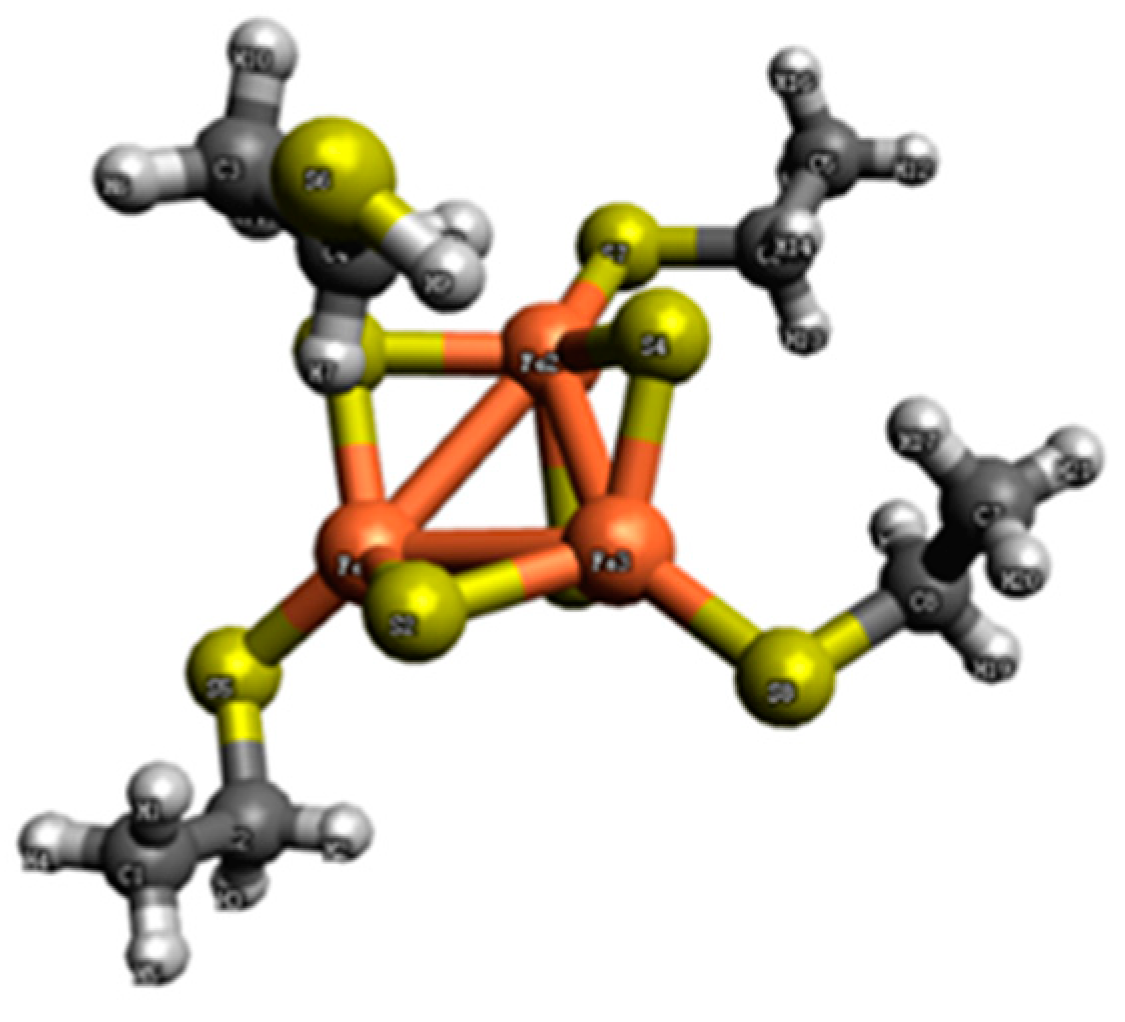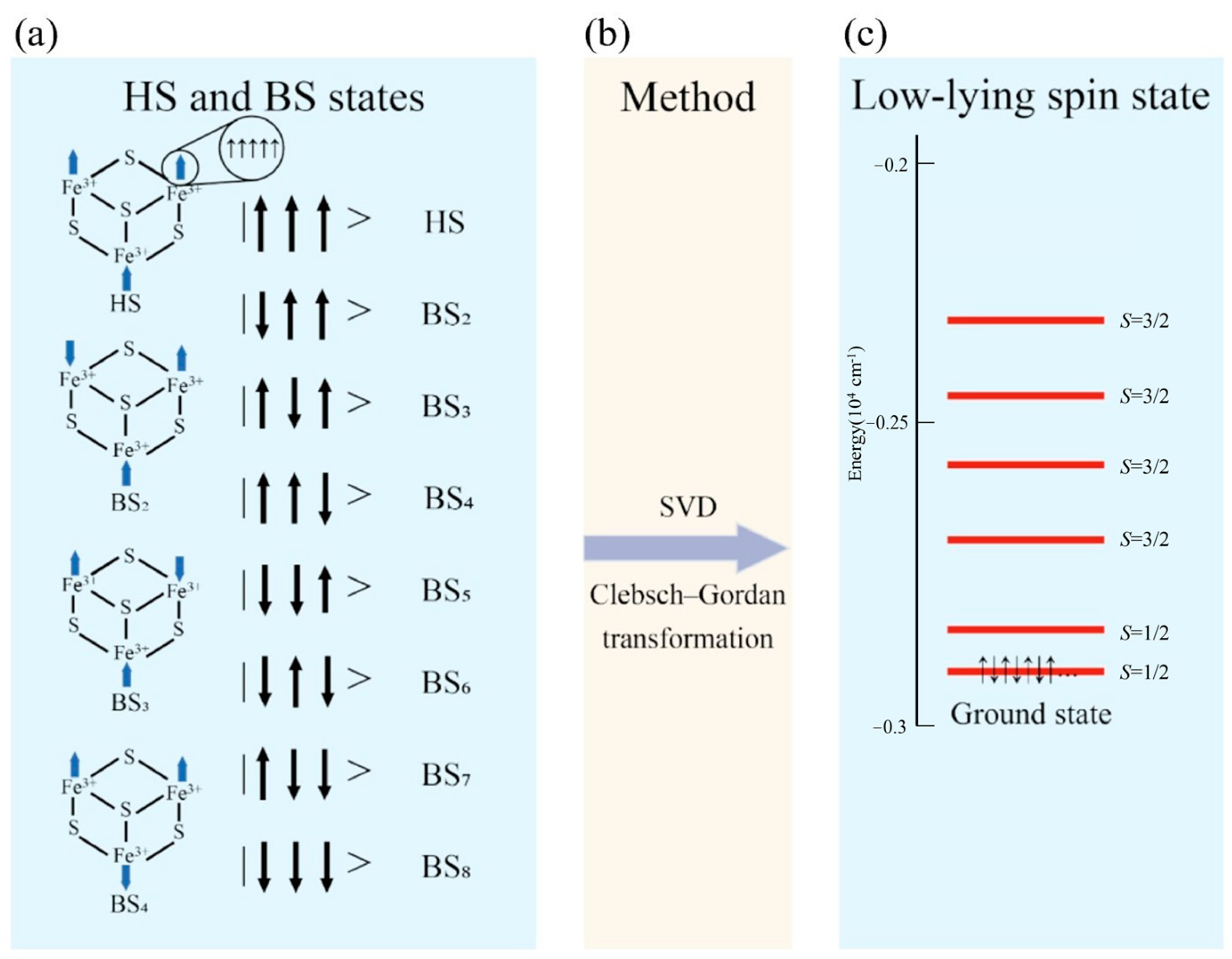Unveiling the Low-Lying Spin States of [Fe3S4] Clusters via the Extended Broken-Symmetry Method
Abstract
:1. Introduction
2. Results and Discussion
2.1. Structure and Spin State
2.2. Bond Lengths between Spin Centers
2.3. Exchange Coupling Constants
2.4. Energy Spectrum
3. Computational Method
4. Conclusions
Author Contributions
Funding
Institutional Review Board Statement
Informed Consent Statement
Data Availability Statement
Conflicts of Interest
References
- Manahan, S.E. Environmental Chemistry; CRC Press: Boca Raton, FL, USA, 2022. [Google Scholar]
- Montzka, S.A.; Dlugokencky, E.J.; Butler, J.H. Non-CO2 greenhouse gases and climate change. Nature 2011, 476, 43–50. [Google Scholar] [CrossRef] [PubMed]
- Sharmila, V.G.; Banu, J.R.; Kim, S.H.; Kumar, G. A review on evaluation of applied pretreatment methods of wastewater towards sustainable H2 generation: Energy efficiency analysis. Int. J. Hydrogen Energy 2020, 45, 8329–8345. [Google Scholar] [CrossRef]
- Ogo, S.; Ando, T.; Mori, Y.; Matsumoto, T.; Yatabe, T.; Yoon, K.S.; Sato, Y.; Hibino, T.; Kaneko, K. A NiRhS fuel cell catalyst–lessons from hydrogenase. Chem. Commun. 2020, 56, 11787–11790. [Google Scholar] [CrossRef] [PubMed]
- Esmieu, C.; Raleiras, P.; Berggren, G. From Protein Engineering to Artificial Enzymes-Biological and Biomimetic Approaches towards Sustainable Hydrogen Production. Sustain. Energy Fuels 2018, 2, 724–750. [Google Scholar] [CrossRef] [PubMed]
- Sun, Y.; Ma, Y.; Zhang, B.; Sun, H.; Wang, N.; Wang, L.; Zhang, J.; Xue, R. Comparison of magnetite/reduced graphene oxide nanocomposites and magnetite nanoparticles on enhancing hydrogen production in dark fermentation. Int. J. Hydrogen Energy 2022, 47, 22359–22370. [Google Scholar] [CrossRef]
- Bockris, J.O.M. The Hydrogen Economy: Its History. Int. J. Hydrogen Energy 2013, 38, 2579–2588. [Google Scholar]
- Tachibana, Y.; Vayssieres, L.; Durrant, J.R. Artificial photosynthesis for solar water-splitting. Nat. Photonics 2012, 6, 511–518. [Google Scholar] [CrossRef]
- Zhang, J.Z.; Reisner, E. Advancing photosystem II photoelectrochemistry for semi-artificial photosynthesis. Nat. Rev. Chem. 2020, 4, 6–21. [Google Scholar] [CrossRef]
- Lv, J.; Xie, J.; Mohamed, A.G.A.; Zhang, X.; Feng, Y.; Jiao, L.; Zhou, F.; Yuan, D.; Wang, Y. Solar utilization beyond photosynthesis. Nat. Rev. Chem. 2023, 7, 91–105. [Google Scholar] [CrossRef] [PubMed]
- Zhang, L.; Morello, G.; Carr, S.B.; Armstrong, F.A. Aerobic photocatalytic H2 production by a [NiFe] hydrogenase engineered to place a silver nanocluster in the electron relay. J. Am. Chem. Soc. 2020, 142, 12699–12707. [Google Scholar] [CrossRef]
- Land, H.; Senger, M.; Berggren, G.; Stripp, S.T. Current state of [FeFe]-hydrogenase research: Biodiversity and spectroscopic investigations. ACS Catal. 2020, 10, 7069–7086. [Google Scholar] [CrossRef]
- Grinter, R.; Kropp, A.; Venugopal, H.; Senger, M.; Badley, J.; Cabotaje, P.R.; Jia, R.; Duan, Z.; Huang, P.; Stripp, T.P. Structural basis for bacterial energy extraction from atmospheric hydrogen. Nature 2023, 615, 541–547. [Google Scholar] [CrossRef] [PubMed]
- Stephenson, M.; Stickland, L.H. Hydrogenase: A bacterial enzyme activating molecular hydrogen. J. Biochem. 1931, 25, 205–214. [Google Scholar] [CrossRef] [PubMed]
- Fontecilla-Camps, J.C.; Volbeda, A.; Cavazza, C.; Nicolet, Y. Structure/function relationships of [NiFe]- and [FeFe]-hydrogenases. Chem. Rev. 2007, 107, 4273–4303. [Google Scholar]
- Greening, C.; Biswas, A.; Carere, C.R.; Jackson, C.J.; Taylor, M.C.; Stott, M.B.; Cook, G.M.; Morales, S.E. Genomic and meta-genomic surveys of hydrogenase distribution indicate hydrogen is a widely utilised energy source for microbial growth and survival. ISME J. 2016, 10, 761–777. [Google Scholar] [CrossRef] [PubMed]
- Morita, R.Y. Is hydrogen the universal energy source for long-term survival? Microb. Ecol. 1999, 38, 307–320. [Google Scholar] [CrossRef] [PubMed]
- Ji, W.Q.; Zhang, K.; Zhan, K.; Wang, P. Advances in research on antiviral activities of sulfated polysaccharides from seaweeds. Chin. J. Struct. Chem. 2022, 5, 15–29. [Google Scholar]
- Lacasse, M.J.; Zamble, D.B. [NiFe]-hydrogenase maturation. Biochemistry 2016, 55, 1689–1701. [Google Scholar] [CrossRef] [PubMed]
- Schilter, D.; Camara, J.M.; Huynh, M.T.; Hammes-Schiffer, S.; Rauchfuss, T.B. Hydrogenase enzymes and their synthetic models: The role of metal hydrides. Chem. Rev. 2016, 116, 8693–8749. [Google Scholar] [CrossRef] [PubMed]
- Kim, D.H.; Kim, M.S. Hydrogenases for biological hydrogen production. Bioresour. Technol. 2011, 8423, 8431. [Google Scholar] [CrossRef] [PubMed]
- Barber, J. A Mechanism for Water Splitting and Oxygen Production in Photosynthesis. Nat. Plants 2017, 3, 17041. [Google Scholar] [CrossRef] [PubMed]
- Tai, H.; Hirota, S. Mechanism and application of the catalytic reaction of [NiFe] hydrogenase: Recent developments. ChemBioChem 2020, 21, 1573–1581. [Google Scholar] [CrossRef]
- Bachmeier, A.S.J.L. Metalloenzymes as Inspirational Electrocatalysts for Artificial Photosynthesis: From Mechanism to Model Devices; Springer: Cham, Switzerland, 2017; pp. 193–206. [Google Scholar]
- Shafaat, H.S.; Rüdiger, O.; Ogata, H.; Lubitz, W. [NiFe] hydrogenases: A common active site for hydrogen metabolism un-der diverse conditions. Biochim. Biophys. Acta Bioenerg. 2013, 1827, 986–1002. [Google Scholar] [CrossRef] [PubMed]
- Fritsch, J.; Lenz, O.; Friedrich, B. Structure, function and biosynthesis of O2-tolerant hydrogenases. Nat. Rev. Microbiol. 2013, 11, 106–114. [Google Scholar] [CrossRef] [PubMed]
- Sholl, D.S.; Steckel, J.A. Density Functional Theory: A Practical Introduction; John Wiley & Sons: Hoboken, NJ, USA, 2022. [Google Scholar]
- Cramer, C.J.; Truhlar, D.G. Density functional theory for transition metals and transition metal chemistry. Phys. Chem. Chem. Phys. 2009, 11, 10757–10816. [Google Scholar] [PubMed]
- Ramos, P.; Pavanello, M. Static correlation density functional theory. arXiv 2019, arXiv:1906.06661. [Google Scholar]
- Qu, Z.; Ma, Y. Variational multistate density functional theory for a balanced treatment of static and dynamic correlations. J. Chem. Theory Comput. 2020, 16, 4912–4922. [Google Scholar] [CrossRef] [PubMed]
- Schlimgen, A.W.; Mazziotti, D.A. Static and dynamic electron correlation in the ligand noninnocent oxidation of nickel dithiolates. J. Phys. Chem. A 2017, 121, 9377–9384. [Google Scholar] [CrossRef] [PubMed]
- Martin, J.M.L.; Santra, G.; Semidalas, E. An exchange-based diagnostic for static correlation. AIP Conf. Proc. 2022, 2611, 020014. [Google Scholar]
- Sandala, G.M.; Hopmann, K.H.; Ghosh, A.; Noodleman, L. Calibration of DFT Functionals for the Prediction of 57Fe Mössbauer Spectral Parameters in Iron–Nitrosyl and Iron–Sulfur Complexes: Accurate Geometries Prove Essential. J. Chem. Theory Comput. 2011, 7, 3232–3247. [Google Scholar] [CrossRef] [PubMed]
- David, G.; Ferré, N.; Le Guennic, B. Consistent Evaluation of Magnetic Exchange Couplings in Multicenter Compounds in KS-DFT: The Recomposition Method. J. Chem. Theory Comput. 2022, 19, 157–173. [Google Scholar] [CrossRef] [PubMed]
- Pantazis, D.A. Meeting the challenge of magnetic coupling in a triply-bridged chromium dimer: Complementary broken-symmetry density functional theory and multireference density matrix renormalization group perspectives. J. Chem. Theory Comput. 2019, 15, 938–948. [Google Scholar] [CrossRef] [PubMed]
- Sharma, S.; Sivalingam, K.; Neese, F.; Chan, G.K.L. Low-energy spectrum of iron–sulfur clusters directly from many-particle quantum mechanics. Nat. Chem. 2014, 6, 927–933. [Google Scholar] [CrossRef] [PubMed]
- Ames, W.; Pantazis, D.A.; Krewald, V.; Cox, N.; Messinger, J.; Lubitz, W.; Neese, F. Theoretical evaluation of structural models of the S2 state in the oxygen evolving complex of photosystem II: Protonation states and magnetic interactions. J. Am. Chem. Soc. 2011, 133, 19743–19757. [Google Scholar] [CrossRef] [PubMed]
- Chu, S.; Bovi, D.; Cappelluti, F.; Orellana, A.G.; Martin, H.; Guidoni, L. Effects of static correlation between spin centers in multicenter transition metal complexes. J. Chem. Theory Comput. 2017, 13, 4675–4683. [Google Scholar] [CrossRef] [PubMed]
- Bisgard, J. Analysis and Linear Algebra: The Singular Value Decomposition and Applications; American Mathematical Society: Providence, RI, USA, 2020. [Google Scholar]
- Lauterbach, L.; Gee, L.B.; Pelmenschikov, V.; Jenney, F.E.; Kamali, S.; Yoda, Y.; Adams, M.W.W.; Cramer, S.P. Characterization of the [3Fe–4S]0/1+ cluster from the D14C variant of Pyrococcus furiosus ferredoxin via combined NRVS and DFT analyses. Dalton Trans. 2016, 45, 7215–7219. [Google Scholar] [CrossRef] [PubMed]
- Zhou, J.; Hu, Z.; Münck, E.; Holm, R.H. The cuboidal Fe3S4 cluster: Synthesis, stability, and geometric and electronic structures in a non-protein environment. J. Am. Chem. Soc. 1996, 118, 1966–1980. [Google Scholar] [CrossRef]
- Yoo, S.J.; Hu, Z.; Goh, C.; Bominaar, E.L.; Holm, R.H.; Münck, E. Determination of the Exchange-Coupling Constant of an Fe3+−Fe3+ Pair in a Cubane-Type Iron− Sulfur Cluster. J. Am. Chem. Soc. 1997, 119, 8732–8733. [Google Scholar] [CrossRef]
- Neese, F. The ORCA program system. WIREs Comput. Mol. Sci. 2012, 2, 73–78. [Google Scholar] [CrossRef]
- Schäfer, A.; Horn, H.; Ahlrichs, R. Fully optimized contracted Gaussian basis sets for atoms Li to Kr. J. Chem. Phys. 1992, 97, 2571–2577. [Google Scholar] [CrossRef]
- Weigend, F.; Ahlrichs, R. Balanced basis sets of split valence, triple zeta valence and quadruple zeta valence quality for H to Rn: Design and assessment of accuracy. Phys. Chem. Chem. Phys. 2005, 7, 3297–3305. [Google Scholar] [CrossRef] [PubMed]
- Jensen, K.P. Bioinorganic Chemistry Modeled with the TPSSh Density Functional. Inorg. Chem. 2008, 47, 10357–10365. [Google Scholar] [CrossRef] [PubMed]
- Pain, J.C. Group theory and the link between expectation values of powers of r and Clebsch-Gordan coefficients. arXiv 2021, arXiv:2101.07872. [Google Scholar]
- Simon, A. Numerical Table of the Clebsch-Gordan Coefficiencts; Oak Ridge National Laboratory: Oak Ridge, TN, USA, 1954. [Google Scholar]







| BSk | Spin State | Stot | |
|---|---|---|---|
| BS1 | ↑↑↑ | ||
| BS2 | ↓↑↑ | ||
| BS3 | ↑↓↑ | ||
| BS4 | ↑↑↓ |
| Hybrid Function | Method | Fe1-Fe2/Å | Fe2-Fe3/Å | Fe1-Fe3/Å | Error/% |
|---|---|---|---|---|---|
| Exp [41] | 2.71 | 2.67 | 2.73 | ||
| B3LYP | HS | 3.05 | 3.07 | 3.06 | 12%~15% |
| BS | 2.88 | 3.03 | 2.90 | 6%~13% | |
| EBS | 2.85 | 2.79 | 2.87 | 4%~5% | |
| TPSSh | HS | 2.99 | 3.02 | 2.99 | 10%~13% |
| BS | 2.76 | 2.95 | 2.79 | 2%~8% | |
| EBS | 2.73 | 2.78 | 2.78 | 0.7%~4% | |
| Hybrid Function | Method | J1/cm−1 | J2/cm−1 | J3/cm−1 |
|---|---|---|---|---|
| B3LYP | BS | −65.4 | −67.5 | −62.1 |
| EBS | −109.5 | −119.8 | −100.9 | |
| TPSSh | BS | −94.0 | −89.0 | −88.5 |
| EBS | −155.7 | −149.6 | −124.3 | |
| Exp [42] | −(200~300), J1 ≈ J2 ≈ J3 | |||
Disclaimer/Publisher’s Note: The statements, opinions and data contained in all publications are solely those of the individual author(s) and contributor(s) and not of MDPI and/or the editor(s). MDPI and/or the editor(s) disclaim responsibility for any injury to people or property resulting from any ideas, methods, instructions or products referred to in the content. |
© 2024 by the authors. Licensee MDPI, Basel, Switzerland. This article is an open access article distributed under the terms and conditions of the Creative Commons Attribution (CC BY) license (https://creativecommons.org/licenses/by/4.0/).
Share and Cite
Chu, S.; Gao, Q. Unveiling the Low-Lying Spin States of [Fe3S4] Clusters via the Extended Broken-Symmetry Method. Molecules 2024, 29, 2152. https://doi.org/10.3390/molecules29092152
Chu S, Gao Q. Unveiling the Low-Lying Spin States of [Fe3S4] Clusters via the Extended Broken-Symmetry Method. Molecules. 2024; 29(9):2152. https://doi.org/10.3390/molecules29092152
Chicago/Turabian StyleChu, Shibing, and Qiuyu Gao. 2024. "Unveiling the Low-Lying Spin States of [Fe3S4] Clusters via the Extended Broken-Symmetry Method" Molecules 29, no. 9: 2152. https://doi.org/10.3390/molecules29092152





